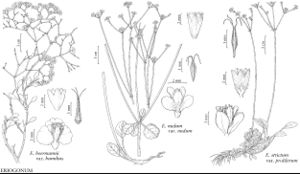Eriogonum heermannii var. humilius
Aliso 7: 226. 1970.
Shrubs or subshrubs, spreading to rounded, usually sparsely branched, 3–7 × 5–12 (–15) dm. Leaf-blades oblanceolate to spatulate, 0.8–1.5 × 0.4–0.8 cm, floccose or glabrous abaxially. Inflorescences 3–15 (–23) × 5–20 cm; branches usually diffuse with dichotomously arranged involucres, slender, round, smooth, glabrous, not spinose. Involucres campanulate, 1–1.5 × 1.5–3 mm. Flowers 2.5–3 mm; perianth white.
Phenology: Flowering Jun–Oct.
Habitat: Limestone or volcanic flats, washes, and slopes, saltbush and sagebrush communities, pinyon-juniper and montane conifer woodlands
Elevation: 1100-2500 m
Discussion
Variety humilius is the common expression of the species in the northern Great Basin, extending from Mono and Inyo counties, California, northeast across Nevada (Carson City, Churchill, Douglas, Elko, Esmeralda, Eureka, Humboldt, Lander, Lyon, Mineral, Nye, Pershing, Storey, and Washoe counties). Plants are usually scattered and the variety is rarely a local dominant; it often grows in volcanic soils. Variety humilius is worthy of cultivation; the large shrubs, when in full flower, can be spectacular.
Selected References
None.
Lower Taxa
"/2" is not declared as a valid unit of measurement for this property."dm" is not declared as a valid unit of measurement for this property."dm" is not declared as a valid unit of measurement for this property."dm" is not declared as a valid unit of measurement for this property.

